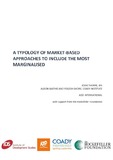| dc.contributor.author | Thorpe, Jodie | |
| dc.contributor.author | Mathie, Alison | |
| dc.contributor.author | Ghore, Yogesh | |
| dc.date.accessioned | 2017-01-17T13:08:41Z | |
| dc.date.available | 2017-01-17T13:08:41Z | |
| dc.date.issued | 2017-01 | |
| dc.identifier.citation | Thorpe, J., Mathie, A. and Ghore, Y. (2017) A Typology of Market-based Approaches to Include the Most Marginalised, Brighton: IDS. | en |
| dc.identifier.uri | https://opendocs.ids.ac.uk/opendocs/handle/20.500.12413/12729 | |
| dc.description.abstract | In recent years there has been a surge of interest in the role that markets and the private sector play in development, and interest to understand how development actors may most effectively support ‘inclusive economies’. What is missing, however, is a systematic analysis of what it takes for market-based approaches to include the most marginalised. In light of the Sustainable Development Goals’ pledge that ‘no one will be left behind’, this research identifies and analyses 22 examples of market-based approaches that show promise in reaching and benefiting extremely marginalised people.
By ‘market-based approaches’ we mean initiatives that generate viable livelihood opportunities by supporting the most marginalised to engage in markets, on better terms, and strengthening demand for the goods or services they produce. By ‘extremely marginalised’ we refer to those living at the intersection of economic and social exclusion, lacking the minimum to meet their basic needs while facing exclusionary social norms due to gender, caste, ethnicity, disability and other factors that leave them in positions of low status and power.
Through a literature review, identification and analysis of the 22 ‘promising’ examples, a series of thought-leader interviews and a multi-stakeholder meeting at the Bellagio Center, the research has systemised the ways in which excluded groups and those supporting them respond to and shape circumstances to enable market inclusion. This report presents the resulting typology of five opportunities and multiple pathways to inclusion, and four core design elements: sector, enabling factors, risk and resilience and financial models. | en |
| dc.description.sponsorship | The Rockefeller Foundation’ | |
| dc.language.iso | en | en |
| dc.publisher | IDS | en |
| dc.rights.uri | http://creativecommons.org/licenses/by-nc/4.0/ | en |
| dc.subject | Trade | en |
| dc.title | A Typology of Market-based Approaches to Include the Most Marginalised | en |
| dc.type | Other | en |
| dc.identifier.team | Business, Markets and the State | en |
| rioxxterms.funder | Default funder | en |
| rioxxterms.identifier.project | Default project | en |
| rioxxterms.version | NA | en |
| rioxxterms.funder.project | c941507f-fd0b-4fc3-9822-4b2132f61a1d | en |


